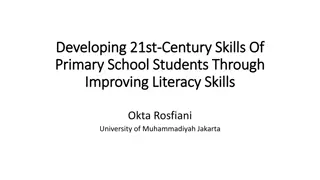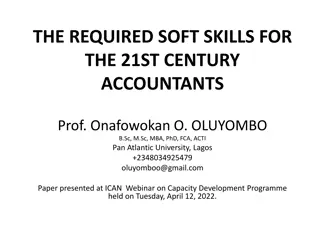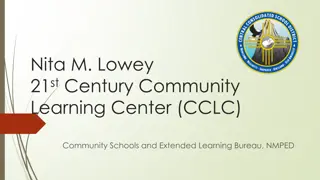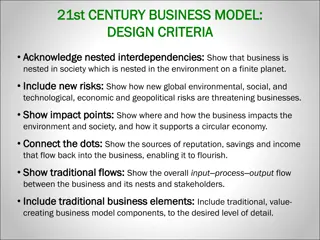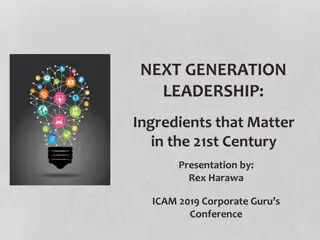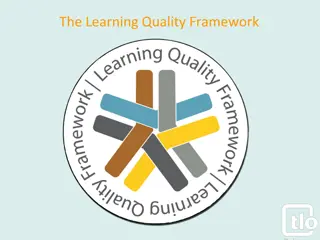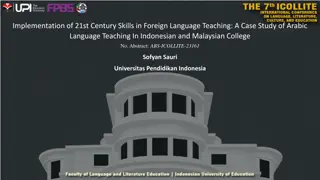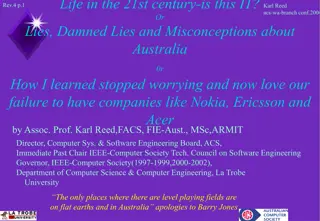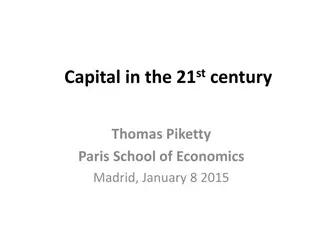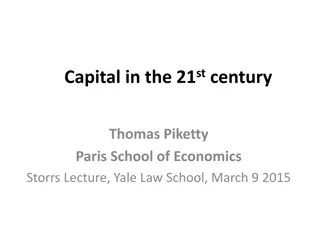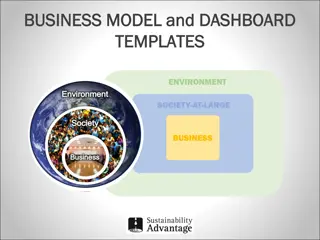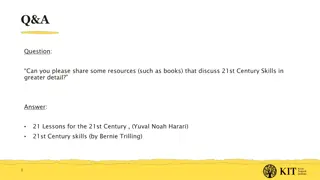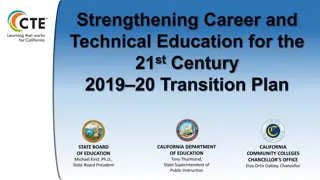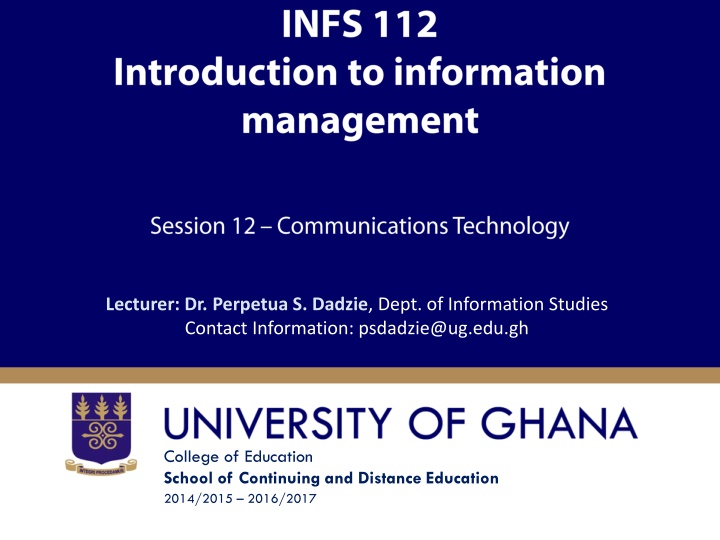
Communications Technology in the 21st Century
Dr. Perpetua S. Dadzie from the Dept. of Information Studies covers the impact of IT on users, ways to use computers for communication, and challenges of IT in the 21st century. The session delves into communication systems, connectivity, and the evolution of mobile telecommunications. Explore key topics such as the overview of communications technology, the impact of information technology, and challenges faced in the IT landscape.
Download Presentation

Please find below an Image/Link to download the presentation.
The content on the website is provided AS IS for your information and personal use only. It may not be sold, licensed, or shared on other websites without obtaining consent from the author. If you encounter any issues during the download, it is possible that the publisher has removed the file from their server.
You are allowed to download the files provided on this website for personal or commercial use, subject to the condition that they are used lawfully. All files are the property of their respective owners.
The content on the website is provided AS IS for your information and personal use only. It may not be sold, licensed, or shared on other websites without obtaining consent from the author.
E N D
Presentation Transcript
Lecturer: Dr. Perpetua S. Dadzie, Dept. of Information Studies Contact Information: psdadzie@ug.edu.gh College of Education School of Continuing and Distance Education 2014/2015 2016/2017
Session Overview At the end of the session, the student will be able to: Explain the different ways to use computers to communicate Discuss the impact of IT on users in different environments Discuss some challenges of IT in the 21st century Slide 2 Dr. Perpetua Dadzie, Dept of Information Studies
Session Outline The key topics to be covered in the session are as follows: Topic One - Overview of Communications Technology Topic Two Impact of Information Technology Topic Three Challenges of IT for the 21st Century Slide 3 Dr. Perpetua Dadzie, Dept of Information Studies
Reading List O Leary and O Leary (2015). Computing Essentials 25th ed. 8 Ten IT challenges for the 21st Century http://www.techrepublic.com/blog/tech-decision-maker/ten- it-challenges-for-the-21st-century/ Slide 4 Dr. Perpetua Dadzie, Dept of Information Studies
Topic One OVERVIEW OF COMMUNICATIONS TECHNOLOGY Slide 5 Dr. Perpetua Dadzie, Dept of Information Studies
Communications Technology In communications, people and resources connected by networks. Connectivity - microcomputer connected to telephone, other telecommunications links, other computers and information sources almost anywhere. Linked to world of larger computers and Internet. Most important changes in connectivity and communications has been widespread use of mobile or wireless telephones.
Communications Technology (7) Communication systems - Four basic elements. Sending and receiving devices - the communication system is able to send and receive messages in the form of data, information and or instructions. Communication channel - system has to pass through some medium either physical wire or cable or wireless connection . Ex. telephone lines, cables and fiber optic (physical channels); Satellite, Bluetooth, microwave, infrared, broadcast radio (wireless channels)
Communications Technology (8) Connection devices system acts as interface between sending and receiving devices and communication channel. Convert outgoing messages into form which travels across communication channel. Also reverse process for incoming messages. Eg. Modem ( Modulator-demodulator); external or internal PC Card modem or wireless. External modem stand apart from system while internal modem consists of plug-in circuit board inside system unit. PC Card modem - credit card-size expansion board inserted into portable computers; wireless modem does not use cable; send and receive messages through air.
Communications Technology (9) Data transmission specification - rules and procedures that coordinate sending and receiving devices by defining exactly how message will be sent across communication channel. Factors affecting how data is transmitted -bandwidth and protocols Bandwidth - measure of communication channel s width or capacity. Higher bandwidth, higher rate of transmission of data. Ex . of bandwidth for high-capacity transmission is Broadband. Broadband services by Vodafone, Airtel, MTN. Protocols - rules for exchanging data between computers
Communications Technology (10) Computer Networks communication system that connects two or more computer to exchange information and share resources Popular computer networks - Local Area Networks (LAN) and Wide Area Networks (WAN). LAN connects nearby devices and WAN spans states and countries or form worldwide networks. Internet example of WAN; Organizations use Internet technologies to support communication within and between organizations through Intranet and Extranet. Intranet is used to provide information to employees. Extranet connects more than one organization.
Video Communication Technology Part 1 <iframe width="420" height="315" src="https://www.youtube.com/embed/K8GjdlsZuGY " frameborder="0" allowfullscreen></iframe>
Topic Two IMPACT OF INFORMATION TECHNOLOGY Slide 12 Dr. Perpetua Dadzie, Dept of Information Studies
Impact of Information Technology Technology plays important role in every sphere of life in Education, in Business, in libraries, Technology s Impact on Education Teaching made interactive Computers offer an interactive audio-visual medium. PowerPoint presentations and animation software can be used to present information in an interactive way.
Impact on Education Technology has eliminated space and time constraints Online education and distance learning have given a new dimension to education and higher learning. Robust information storage Computers enable better and more robust storage of information. Information is easily accessible The Internet is a huge information base. It can be used as an effective tool for acquiring knowledge.
Impact on Education Technology has eliminated space and time constraints Online education and distance learning have given a new dimension to education and higher learning. Robust information storage Computers enable better and more robust storage of information. Information is easily accessible The Internet is a huge information base. It can be used as an effective tool for acquiring knowledge.
Impact on Education (2) Knowledge sharing made easy Increased retention of information Greater interest in learning Better presentation of information
Impact on Libraries Key Impacts of Technology Collection Development Information access Communities and collaborations Training and support User Services
Impact on Business Information technology (IT) is dramatically changing the business landscape Key impacts of technology are: Business strategy - collapsing time and distance, enabling electronic commerce Organization Culture - encouraging the free flow of information Organization Structures - making networking and virtual corporations a reality Management Processes - providing support for complex decision making processes Work - dramatically changing the nature of professional, and now managerial work The workplace - allowing work from home and on the move, as in telework
Impact on Governments Key Impacts of technology: collate and monitor statistical information that can be used use to combat fraud and manage the economy in a more informed way. IT has also had a major impact on the defense capabilities of governments, government's intelligence agencies and also led to the enactment of new legislation for IT use.
Activity Describe the role of Information technology in Government, Health institutions, News agencies
Topic Three CHALLENGES OF IT IN THE 21ST CENTURY Slide 21 Dr. Perpetua Dadzie, Dept of Information Studies
Challenges of IT Globalization: Virtually every company today must compete globally Excess Workload: Customers are becoming more demanding, especially as we see a growth in competition This is both a challenge and an opportunity. Demand for science and IT professionals is growing at a 5% annual rate, while those deciding to earn Computer Science related degrees is in a downward trend. Change: It has been said that the only constant is change.
Challenges of IT (2) Cultural Differences: Outsourcing and Off Shoring: Project Management Meeting Customer Expectation Planning
Activity Discuss other challenges you envisage to happen with the advancement of information technology
References ******



